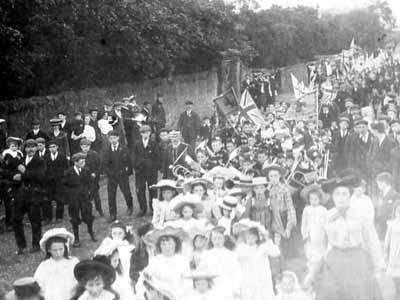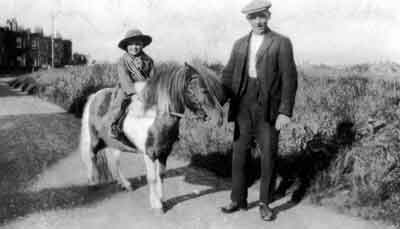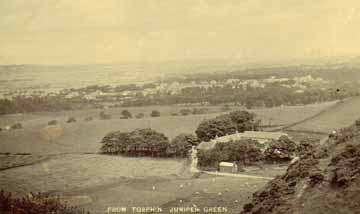Memories of Juniper Green
Sheila Wilson and Jean Brown remember...
This article comes from reminiscences by Sheila and Jean in conversation with Christine McBean & Liz Beevers on the 4th November 2006 in the Village Hall.
St Anns, 14 Belmont Road.
Jean: My Grandmother, Mrs Muir, came from the west and they bought St Anns on Belmont Road. It was originally a cottage but they added the second floor to it about 1870. Yes, my mother was born in 1886 so it would be in the 1870's.
Jenny Cairns used to help our grandmother. Jennie used to live at the foot of St Ann's driveway. If you're going down Belmont Road (westwards) then St Anns is the house on the right. When my grandmother died my mother rented St Anns to the Bryces - two sisters called Lilias and Nina. Nina had a dairy - a little one up the street. When they left they just went right across the street to live.
Christine: Did your grandmother build other houses?
Jean: Yes, the four brick cottages near the tennis courts. It used to be called St Anns Park when she bought it. The land was all under Foulis then. I've never known where the name came from. There is no 'e' and no apostrophe.
A First Memory of Juniper Green and Bloomiehall Park
Sheila: I was born at number 70 Belmont Road 80 years ago.
My first memory was that I had to go to Chalmers Hospital and I came home by the bus, the number 15. When I walked down from the terminus which was on the main road just where Iceland supermarket is now, I was so happy to see the house because I was walking with 2 sticks at the time and I was able to walk all that way. I must have been about 3 years old at the time. They would bring me grapes into hospital which was a real treat in those days.
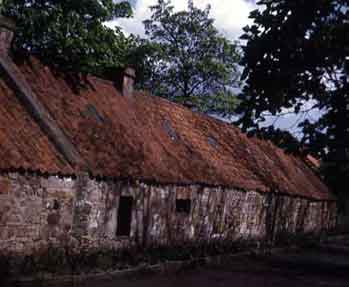
The byre at the East end of Bloomiehall Park indicates that the area had been farmland in earlier times.
I remember Bloomiehall Park - the holly tree at this end (east end) and the wee lambs in the Spring would run round and round and round this holly tree. The Ladies toilet was discreetly built behind a group of trees there and the Gents was at the far end. But there were lambs and cows. Mr Clark had the cows. Many many Churches from Edinburgh used the park for their Sunday School picnics. Lorries would arrive with folding tables and big bakers trays full of bags of pies and cakes and everything would be set up before the children arrived in buses with streamers etc.
There were swings but they were at this end (east end) of the park. The park was locked every night at 8 p.m.
Some of the houses of Juniper Green
Where Juniper Grove is now there was a small estate called Walkerfield. I don't know why it was called that because a Mrs Aitken owned it and she lived in the big house at the top now converted into two flats. She built some houses in the village and gave them to the Blind Asylum for blind servicemen returning from the war.
All the houses in the village had names - right up until 1964 when the post office numbered all the houses to make it easier for the postmen to deliver the mail.
There used to be a cottage at the right hand side of the Baberton Golf Course entrance. The people who lived there had a fruiterer's van and their name was Fisher. You can still see one of the carved pillars today.
The Village Hall was a great place and widely used. Whist Drives were very popular and taken very seriously. I remember when I was 15 I went along to my first night of whist - I hadn't a clue what I was meant to do but with a lot of help from my partner I managed to play the winning card and came away with the first prize - a dozen fresh eggs - much to the annoyance of all the serious whist players who usually won all the prizes!
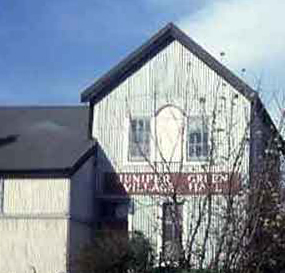
The Village Hall in Juniper Green has been the place for many community activities over the years.
There was Juniper Light Orchestra too which gave lovely concerts. Jean's mother played the piano and her brother John Muir played the violin in the orchestra. There was also John Leishman, John Miller and Edwin Lucas, all members of the orchestra. The annual Flower Shows and Bird Shows were very popular and every year there was a parade to raise funds for the Edinburgh Royal Infirmary. All the children would dress up and lorries would be decorated and the floats paraded round the streets and collected money from the many spectators. It was all great fun.
Across from the entrance to the village hall a soup kitchen was built during the Second World War. This replaced a row of four very old cottages with outside toilets. The gardens stretched down to beyond the tennis courts to Belmont Road. Annie Corse was the chief cook for meals for the elderly which were delivered to their homes and also school dinners for the children. The Kitchens closed about 1980 I think and for a while a drama company used the accommodation for storing costumes and scenery. It was eventually pulled down and replaced by three private houses.
The Gaun Aboot Wuman
I was very young but I think her name was Annie Kane and she was known as 'the gaun aboot body'. She went about and I have a lovely photograph of her. She did not have a house to live in but she always got somewhere to sleep - a barn or somewhere like that - and she had a big black brolly. I think that she was a wee bit odd but people would give her 'pieces' and occasionally money and stuff. She didn't sell anything. I don't know where she came from but she was there for a long time, mostly in Juniper Green. When she died, there was a public collection to pay her burial in Currie Cemetery.
Bryce's Shop in Juniper Avenue.
Jean; There was a little shop on Juniper Avenue that the Bryce sisters Lillias and Nina had. It was Bryce's shop. She sold sweeties and milk and you took your pitcher up which was made of some kind of metal like pewter - not aluminium. She would put it into this bag thing and filled it up; it had a funny top that fitted right inside the pitcher so you didn't spill a drop. Eventually bottles were introduced and you got your milk in a bottle. It was near the entrance to Juniper Place. There were eight houses there. There was a large family of Bryces; one of the brothers was a contractor; two drove lorries and Johnny Bryce had a piggery: he also had cows and delivered milk on a Friday with his pony and trap. Johnnie was a great dancer.
Frances Turner
Sheila went to the convent at Craiglockhart.
How did you travel there?
Sheila: There was a dear lady, now departed, called Frances Turner and she came every morning. She stayed opposite Robin Veitch just at the beginning of Lanark Road West, and she took me on the SMT bus and she would put me off at the top gate. I sometimes stayed there, yes occasionally. It was a day school and a college - a big place and of course it was Catholic. I went there just because it was convenient.
Francis was an absolute pet. She introduced me to golf at Torphin. I would get my clubs (indicating tucking them under her arm) and off I'd go! She was the daughter of the builder of St Andrew's Church and St Margaret's Church and they put in a clause in the time of Dr Grant that there were to be no whist drives and no lotteries in St Andrews Church. Frances lived to be over 100 years old and she is buried in Currie Cemetery.
Miss Benson's Shop
Just about where today's road Baberton Park meets Baberton Avenue there was a sweetie shop belonging to Mrs Benson.
The Store - St Cuthberts
Jean: I was introduced to the co-op. I didn't know anything about a co-op when I came over from Canada in 1962 to live. My cousin, Georgie, she lived in St Anns at that time. She took me up and showed me how to get my 'divi'. I used to shop in Scotts too. I got milk from the Co-op because they delivered in those days.
Christine: I remember buying my boys' school uniforms in the co-op haberdashery department when they went to Nether Currie School. They supplied ties, caps, blazers, badges of the various schools and shoes.
Sheila: Shoes were downstairs and they sold material in the haberdashery. Under the archway there were the horses. The grocer's then the butcher's and the baker were all in that building.
Butcher and baker!
I could tell you two stories. When I was wee I was sent up with a little line for a cow's tail and a haugh bone. Well, the butcher was quite a wag and he wrote on it "Neigh tails today" and sent me back down. But the funniest was when I was there at the baker's which had four little windows and there was Peggy the assistant, a lovely lady; she had elephantiasis but she had a lovely sense of humour and the people lined up to get their iced buns and other things. She was putting them into a paper bag when she looked out of the window and a great big rat popped out but Peggy was not the least perturbed and she said "That's a shame and it's not even got a number.
The Miss Grahams: the Post Office and the papers.
Sheila: Papers - Miss Graham at the Post Office had a sister who stayed up quite near Scott's. The house is still there although it has been altered. She had a lovely wee newsagent. My paper was Arthur Mee's weekly and she used to keep it for me. It cost 3 pence - old money. She was a lovely lady and very approachable. Her sister, Miss Graham who had the Post Office was a right dragon. Woe betide you if you crossed her. She ran the Post Office herself. During the war when there were casualties, they used to send yellow enveloped messages and outside there was a wee fellow with his bike and hat - the telegram boy; he delivered the telegrams. You knew right away when a yellow one came. She would say to him "Be quick and deliver it!" This was the Second World War.
She mostly sold papers and a bit of stationery. Walter Scott took over from Miss Graham then Mr Middleton. They had to deal with the post there and going back a bit they had to go down the brae and meet the train to collect the post. At the back of the Post Office they had to do all the sorting of the mail.
The SMT Buses
Sheila: Yes, they went out to Balerno. It was awful when we heard that the terminus was being moved from Juniper to Balerno for we thought that we would never get on. But I can remember in the summertime lots of people came out of town and they would walk on the hills but they all came back to the Juniper terminus at night. They would be very hot and tired and the neighbours would take chairs out for them to sit on until the bus came. Some people thought that the drivers were sitting looking in their windows but I don't think that was true.
Leerie the Lamplighter and Hammy the Sweep
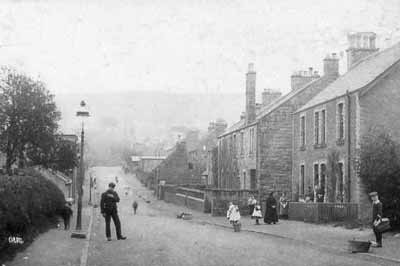
Belmont Avenue (now called Juniper Avenue) with its gas lamps for Leerie to light.
Sheila: I can remember Leerie going round. We always called him Leerie; I think that his name was John Noble. He would go to every gas lamp where he would rest his ladder on the bracket at the top though sometimes he used a long pole and then he would light them with his wee lighter. There was a wee meter to turn them off.
There was a Mr Hamilton, known as Hammy who lived locally in Woodhall Drive. Everyone knew him as Hammy the Sweep. He worked for Mr Howitt the joiner but every Monday he went out to sweep chimneys - only on Mondays. His wife bought him baccy once a week and he popped it into his pipe. When he had baccy, his pipe was up the way but when he had finished it he turned the pipe down the way. He had brushes and extensions but his brush had about two whiskers on it. He was engaged in all kinds of chimney jobs. He had a very upstanding brother who was the Head Warden at Saughton Prison.
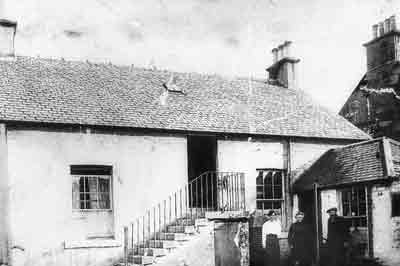
Park End Cottage at 82 Belmont Road in the early 1900s near to where Sheila Wilson has lived all her life.
I remember paying to have electricity installed in my house (70 Belmont Road).
Other Tradesmen and Women
The coal came into the sidings near Kate's Mill and the coalman would just go down there to fill the sacks. He was Mr Notman's father and he had a horse and cart. His son carried on the business after he retired.
There was a man came once a week called the 'brock man' who collected all the vegetable peelings; he would then take them up to the farm at Woodhall to feed the pigs. It was a very smelly job and he kept it all in pails.
The fishwife, Maggie, came to the bank corner and stood there with her creel. She was there until 1962-63 all the way up from Port Seton on the bus in her striped fishwife's dress. We would buy the fish from her and she gutted them on the spot. The other passengers on the bus complained bitterly. She would sit the creel on the back of the bus on the platform.
I remember the fish and chip man coming round. He lit a little fire on the wooden van to heat the fat which was a very dangerous thing to do. He wouldn't get away with that today!! It was very good fish and chips though.
The rag and bone man would come round collecting any old clothes or rags and also jam jars. The children used to love running to him with something because he gave them a balloon in return.

